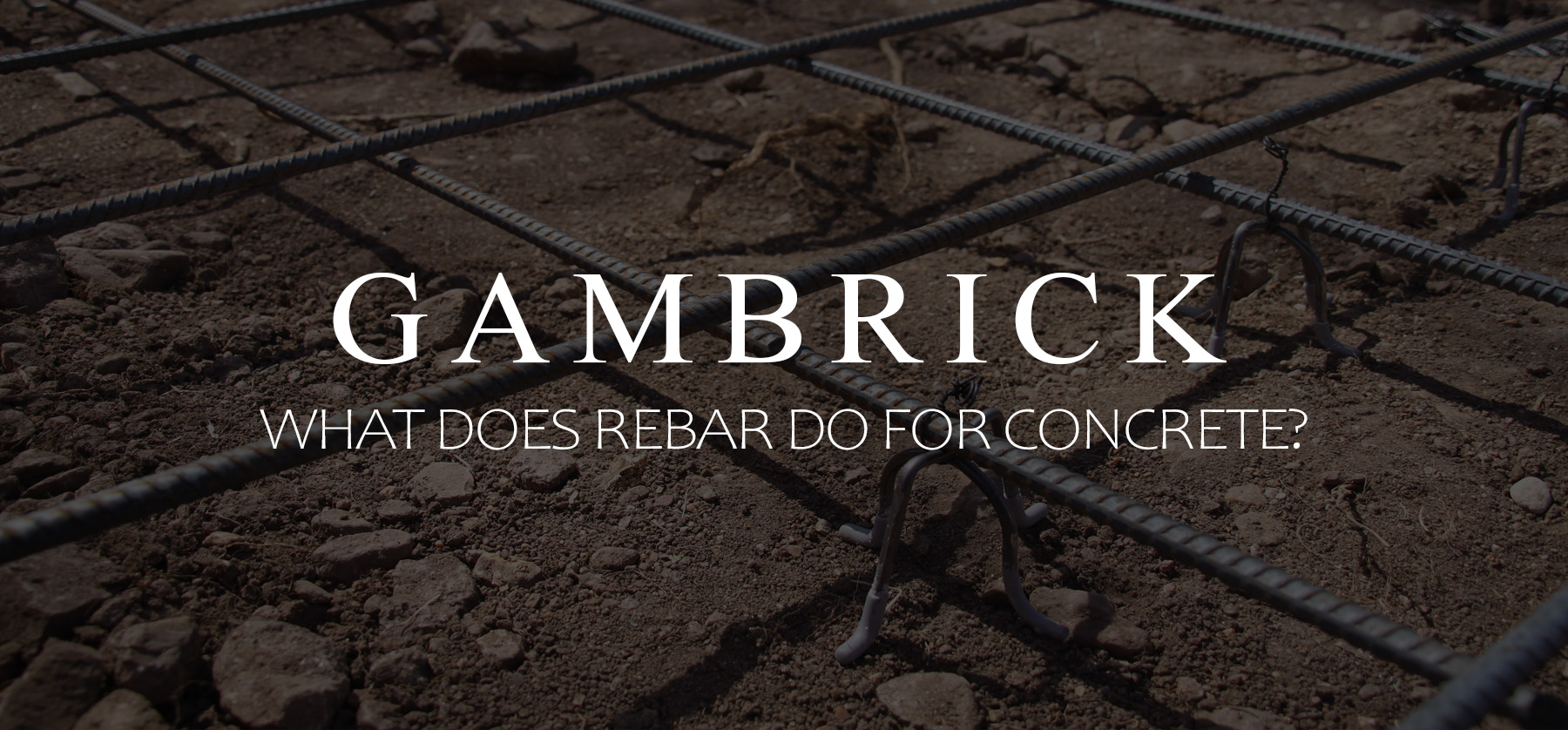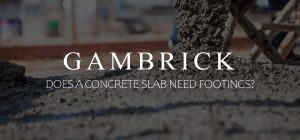
What Does Rebar Do For Concrete?
Concrete is a fantastic building materials that’s been used all over the world for centuries to build foundations, slabs, sidewalks, patios, and large scale industrial and commercial projects like bridges, buildings and dams. Small decorative projects like cast fireplace surrounds, countertops and planters are made from concrete too. It’s main attribute is durability, resistance to the elements and compressive strength. Meaning it can support a lot of weight without cracking. But where it’s weak is it’s tensile strength. However this can be fixed by adding rebar. A.K.A. reinforcing bar. What does rebar do for concrete? It greatly increases it’s strength by creating a metal skeleton inside.
Rebar’s primary purpose is to increase the tensile strength of concrete. This additional strength helps it resist cracks and compensates for concrete’s inherent weakness, like cracking in cold weather due to temperature fluctuations and freezing water. This is a huge help for foundations, patios, sidewalks, and concrete driveways.
With greater tensile strength, concrete is able to resist breaking under tension which means it can safely span larger distances. It’s because of rebar being used in concrete that we have many of the bridges, dams and buildings you see today. Most of the large scale construction and residential structures built today wouldn’t be possible without rebar.
Ahead we’ll learn more about what rebar does for concrete, when and how to use it, and some helpful tips.
Understanding Concrete
Concrete is made by mixing cement, sand and aggregate stone with water. The water chemically reacts with cement which forms a paste that dries and hardens over a period of time called curing. Generally this takes 28 days to complete. During this time, concrete dries, heats up, hardens and grows very strong with a high compressive strength. But a very low amount of tensile strength.
While cement and water are the active ingredients, sand and aggregate stone provide strength to the concrete. Without these two ingredients, cement is much weaker and prone to cracks.
Concrete is a porous material that absorbs water. As the concrete cures, internal water evaporates out which creates lots of small tubes throughout the structure. Water is easily absorbed into these tubes like a sponge.
While concrete’s structure gives it a lot of compressive strength, it has very low tensile strength. These internal tubes and pores can easily crack. For example, even a thick concrete beam supported at both ends has very little strength in the middle and can eventually crack even under it’s own weight.
Concrete’s strength is measured in psi or pounds per square inch. This is a measurement of it’s compression strength. A 3500 psi bag of concrete can resist 3500 pounds per square inch without cracking. But this 3500 psi has nothing to do with it’s tensile strength.
The compressive strength of concrete can be adjusted by changing the type, size and amounts of it’s aggregate. However none of this will do much to alter it’s compressive strength.
Adding concrete reinforcement like wire mesh, chemicals, fiber and rebar are the only way to significantly increase it’s tensile strength.
Understanding Rebar
Rebar provides additional tensile strength to a concrete structure. It helps distribute weight and tie the structure together which prevents cracks and structural damage.
Concrete by itself is a very strong and durable building material. It’s been used all over the world to build structures for centuries. But those structures had big limitations until rebar was invented. These days we can build just about anything out of concrete thanks to the inclusion of rebar inside the concrete.
Concrete performs especially well under compression forces but it needs help to handle the weight of tension. For example weight in the middle of a beam that’s supported on each end but not in the middle. Historically concrete couldn’t span long distances because it would crack in the center where tensile stress is highest. But with rebar it can. This is how large concrete structures are built.
Concrete with a compression strength of 4,000 psi (pounds per square inch) might only have a tensile strength of just 400 psi. That’s very low in comparison. However, by including rebar, tensile strength can actually get higher than concrete’s compression strength.
Rebar also helps deal with expansion and contraction forces that occur naturally with changes in temperature. Rebar helps hold a concrete structure together as it tries to expand and contract.
The rebar inside of a concrete structure can be just as important as what’s on the surface. When you see a concrete building, foundation, bridge or wall, know that inside is generally a well engineered rebar structure that gives it strength. It’s rebar that makes most modern structures possible.
Characteristics Of Rebar
While concrete is extremely durable with fantastic compressive strength, it has some major weaknesses. Having a low tensile strength makes it near worthless as a building material for most modern structures. Without rebar, most concrete structures couldn’t be built. They simply wouldn’t be able to handle the forces placed upon them. Because reinforcing steel has incredible tensile strength, concrete can now absorb stretching and bending forces which allows the concrete to remain firm and strong.
Rebar comes in a variety of grades and thicknesses. Common sizes range from #3 to #18. The number refers to the rebars thickness. The thicker the rebar the stronger it is. Engineers will select the proper grade and thickness depending on the needs of the structure. Rebar is very hard to bend and even harder to pull apart. Both of those benefits increase the tensile strength of concrete. Because in order for the concrete to stretch or bend, the rebar will have to stretch and bend too.
Rebar is generally tied together to form an interlocking skeleton for the concrete. When we pour a solid concrete foundation, all the rebar is secured and tied together first before any concrete is poured.
Spacing the rebar correctly is critical. Rebar that’s off by just an inch can reduce the overall strength of the concrete by 20 percent. That’s why rebar has it’s own inspection. Because it’s very important to the strength of the structure.
The ridges you see in rebar help it make a tight bond with the concrete. Smooth bars are hard for the concrete to grip. But ridges make it very easy. It you want to pull rebar out of concrete you have to break the concrete’s structure which isn’t easy to do.
Why Rebar Makes Concrete Stronger
Because concrete structures almost always experiences compression and tensile loads, you need the concrete to handle both. However, concrete alone doesn’t handle tensile strength very well.
If you put weight on a concrete beam from above, it will hold up against the compression wherever the load points are. Assuming it has the required psi. However, it will also experience severe tensile stress where there’s no support. Such as in the middle of the beam. This creates a situation that can easily result in cracks and structural failures.
This is in addition to vibration, movement and expansion/contraction of the concrete and earth. All of these forces are tensile in nature which is a big weakness for concrete.
Rebar helps alleviate these stresses because, unlike concrete, it has great tensile strength. As a result, including rebar inside of concrete helps strengthen it in all the ways it needs most.
Types Of Rebar
Rebar comes as “deformed” or “plain.” Deformed means the rebar has ridges which helps create a bond with the concrete. Plain rebar doesn’t have the ridges and is used when the steel must “slide” into the concrete.
Here are the most common types of rebar.
- Carbon Steel. The most common type of rebar used. It has a fairly low cost and provides good strength although it corrodes easily when exposed to the elements.
- Glass Fiber Reinforced Polymer (GFRP). A.K.A. “fiberglass rebar.” A good alternative to traditional steel rebar because it has even more tensile strength. It’s made of a resin wrapped with fiberglass which is why it will never corrode. It’s very strong but is also very expensive.
- European. A cheaper type of rebar made from manganese. It’s measured in different formats than what we use in America. It provides solid reinforcement for structural concrete.
- Epoxy Coated. Also known as “green bar.” It’s used mainly to build bridges or in other wet environments because it’s very resistant to corrosion. It’s an economical rebar designed for corrosive environments. The rebar is coated in epoxy which protects it from corrosion. However, in environments where shifting earth, cracks or vibrations may damage the protective coating it’s not a good choice. Cracks expose the steel which nullifies the coating’s effect.
- Galvanized. Very resistant to corrosion, much like epoxy coated rebar, but it’s more expensive. Galvanized rebar is coated with zinc using several different processes including cold plating, hot plating and electroplating. The zinc provides a protective barrier over the steel.
- Stainless Steel Rebar: This is the most expensive rebar, but it’s also very strong and highly resistant to corrosion. Primarily used when zinc and epoxy can’t be used. Because of it’s extremely high cost, it’s only used when absolutely necessary.
Rebar Sizes
Rebar comes in different sizes which are all numbered. The higher the number the thicker the rebar. In the United States, we use the imperial bar size (i.e. #3 or #4) instead of the “soft” metric sizing (ie. #10 or #13).
Both the type and size rebar you need as well as how it’s to be used inside the concrete will be determined by an architect or engineer. When you look at a set of blueprints, there will be detail drawings which show the rebar positioning inside the structure as well as it’s thickness and how the rebar sections are secured to each other.
It’s very important to follow the engineers blueprint exactly as designed. Because even small variations can effect the strength of the concrete structure.
| #3 | #10 | 0.376 | 0.561 | 0.375 | 9.525 | 0.11 | 71 |
| #4 | #13 | 0.668 | 0.996 | 0.500 | 12.7 | 0.2 | 129 |
| #5 | #16 | 1.043 | 1.556 | 0.625 | 15.875 | 0.31 | 200 |
| #6 | #19 | 1.502 | 2.24 | 0.750 | 19.05 | 0.44 | 284 |
| #7 | #22 | 2.044 | 3.049 | 0.875 | 22.225 | 0.6 | 387 |
| #8 | #25 | 2.67 | 3.982 | 1.000 | 25.4 | 0.79 | 509 |
| #9 | #29 | 3.4 | 5.071 | 1.128 | 28.65 | 1 | 645 |
| #10 | #32 | 4.303 | 6.418 | 1.27 | 32.26 | 1.27 | 819 |
| #11 | #36 | 5.313 | 7.924 | 1.41 | 35.81 | 1.56 | 1006 |
| #14 | #43 | 7.65 | 11.41 | 1.693 | 43 | 2.25 | 1452 |
| #18 | #57 | 13.6 | 20.284 | 2.257 | 57.33 | 4 | 2581 |
Compressive VS Tensile Strength
A concrete’s compressive strength is the resistance to breaking under compression, or weight, after it has set and cured. This is usually measured in megapascals (MPa) or pounds per square inch (psi). Each concrete mixture will have a different compressive strength depending on what ingredients were used and they’re ratios. The amount of water used is also a major factor.
Most concrete’s compressive strength varies between 2500 psi (17 MPa) and 5000 psi (34.5 MPa). This is measured at peak strength after 28 days of curing. For example, at 10 days of curing a 5000 psi concrete may only be around 2000 psi. This is why heavy loads aren’t built atop structural concrete until it’s fully cured.
However strong the concrete is, its tensile strength is generally around 1/10th of that value. For concrete that’s 3000 psi (20 MPa), its tensile strength is only around 300 (4 MPa). This is why concrete without rebar tends to crack so easily. Especially when it’s not laying flat on the ground and fully supported.
When rebar is added to concrete it increases it’s tensile strength and prevents cracking that could compromise the integrity of the structure. Parking garages are a great example of a large concrete structure that could not be built out of concrete without rebar.
However things like a driveway don’t generally need reinforcement because the concrete sits directly on flat earth. Even if the vehicles are very heavy the concrete only need compressive strength to support them. But if there’s a sink hole beneath the driveway, rebar will be needed to span the gap.
Base Material
The base is a layer of material that’s placed under the concrete before it’s poured. Base material is poured on top of compacted earth. Both elements act as a foundation for the concrete and the weight above. As long as the concrete is evenly supported on flat base and earth, the need for rebar is reduced.
However rebar is generally still used inside concrete structures that have to bear a lot of weight. Even when the concrete rests on compacted earth and base. This is typically because of a few factors.
- Expansion & Contraction. Concrete will naturally expand and contract as the temperature changes. This can create a lot of pressure on the concrete. For this reason rebar is used along with expansion joints to support and relieve the pressure. Expansion and contraction are considered tensile strength issues.
- Changes. If you can guarantee the earth beneath a structure will never change, rebar won;t be ass needed. But you generally can’t. Because the situation beneath a concrete footing can change we include rebar just in case. If for example a sink hole or settlement opens up beneath a footing, the rebar should be strong enough to span the gap and prevent the concrete from cracking.
- Overload. If the weight on top of your structure is enough to crack the concrete, rebar will hold it together. Even when cracked, a concrete structure held together by rebar can still be very strong. In some cases just as strong as if the concrete were still intact.
Throughout my entire career as a builder I have never built anything structural out of concrete and not included rebar.
The Thickness Of Concrete
The recommended minimum thickness for poured concrete is generally 4 inches. This is typically too thin for rebar so we use wire mesh instead. However, when concrete is 5 inches thick and above we start using rebar. And as the concrete gets thicker and needs to support more load, the rebar gets thicker and more elaborate too.
As concrete gets thicker, in some cases several feet, we build rebar cages. Multiple layers of rebar flow through the concrete structure held together by even more rebar. In general, we use a combination of vertical and horizontal rebar inside all of our footings and walls.
Another important element to consider is how all that rebar is secured together. Thin metal ties are twisted together like string to hold rebar together before the concrete is poured. It looks like a sort of thin metal skeleton for the concrete. And in some rare cases we even include wire mesh and other additives like chemical strengtheners and fiber.
Reduced Thickness
One of the many benefits to using rebar is that it can potentially reduce the thickness of the concrete. When load calculations are done to determine the thickness a slab needs to be, they can often be thinner by adding strong rebar. This can have all sorts of benefits including space and money savings.
Rebar Positioning
Just putting rebar in and pouring concrete isn’t enough. Rebar needs to be stable so that it doesn’t move around while you pour the concrete. And where the rebar is positioned is very important too. Even small changes in location from the plans can weaken a structure quite a bit.
Each project is different so I can’t give you specific positions or distances here. An architect or engineer needs to design the rebar as well as spec a concrete strength for your project. As with any concrete project, if you’re unsure whether or not you need reinforcement, it’s always best to consult a professional.
However we can tell you how important it is to take your time and build the rebar cages correctly. Make sure to get all your sizes and distances exactly right. And make sure the rebar is very secure so that it doesn’t shift when you pour the concrete. Many concrete structures have failed because the rebar wasn’t done correctly.
- First, make sure the rebar is all the correct size.
- Second, make sure each bar is in it’s correct position.
- Third, check to make sure each connection is strong and the rebar cage is strong.
- Finally, pour the concrete.
Wire Mesh Vs Rebar
Rebar adds a great deal of strength to a concrete structure. Generally it’s used in large scale projects where concrete needs a lot of strength to keep it from cracking or breaking apart, such as a wall or foundation. A 4″ thick concrete sidewalk doesn’t typically require rebar. However, a 12″ thick concrete footing generally has some inside to prevent it from cracking.
Wire Mesh is made from thin stainless steel wires formed into a grid pattern. It comes in a roll that’s typically 4′ wide x various lengths. We generally buy rolls that are 100′ long. Wider sheets are also available by special order if you need them. Wire mesh is added into concrete to increase it’s strength in much the same way as rebar. However, mesh isn’t nearly as strong as rebar since the wires are not as thick. We generally use wire mesh in much smaller situations like a floor slab. However, it’s sometimes used along side rebar in large scale construction projects as a way to hold concrete together.
Rebar is designed to add strength. It helps prevent structural or foundational cracking. Wire mesh is designed to prevent cracking in smaller projects and isn’t meant for high strength areas like a foundation or large beam.
Rebar tends to cost more than 5x the price of wire mesh. However this varies based on the size of the rebar your using and the amount of labor it takes to create the rebar structure. Wire mesh is much easier to work with because typically all you do is roll it out, cut it to length and position it as needed.
Summary: What Does Rebar Do For Concrete?
Concrete is a fantastic building materials that’s been used all over the world for centuries. Foundations, slabs, sidewalks, patios, and walls are all made from concrete. And so are huge scale industrial and commercial projects like bridges, buildings and dams. Small decorative projects like cast fireplace surrounds, countertops and planters are made from concrete too. It’s main attribute is durability, resistance to the elements and compressive strength. Meaning it can support a lot of weight without cracking. But where it’s weak is it’s tensile strength. However this can be fixed by adding rebar. A.K.A. reinforcing bar. What does rebar do for concrete? It greatly increases it’s strength by creating a metal skeleton inside.
Rebar’s primary purpose is to increase the tensile strength of concrete. This additional strength helps it resist cracking and compensates for concrete’s inherent weakness. With greater tensile strength, concrete is able to resist breaking under tension which means it can safely span larger distances. It’s because of rebar being used in concrete that we have many of the bridges, dams and buildings you see today. Most of the large scale construction and residential structures built today wouldn’t be possible without rebar.
If you have any questions or comments e-mail us any time. We’d love to hear from you.

John Mazzuca | About | More Posts |
Custom Home Builder
John Mazzuca is a custom home designer and builder at Gambrick with over 25 years experience in the construction industry. John has designed, built and/or remodeled hundreds of homes, small buildings, and commercial projects. He writes about business, real estate, home building, and household electronics. His work has been featured in Fox Business, Better Homes & Garden, House Beautiful, and more.




















